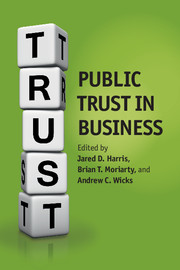Book contents
- Frontmatter
- Contents
- List of figures
- List of tables
- Notes on contributors
- Preface: discovering new territory in public trust in business
- Acknowledgments
- 1 Public trust in business: what’s the problem and why does it matter?
- Part I Trusting the institution of business
- Part II Public trust and business organizations
- 7 Public trust and trust in particular firm–stakeholder interactions: a theoretical model and implications for management
- 8 Creating more trusting and trustworthy organizations: exploring the foundations and benefits of presumptive trust
- 9 Building trust through reputation management
- 10 Can trust flourish where institutionalized distrust reigns?
- 11 Roles of third parties in trust repair: lessons from high-tech alliances for public trust
- 12 The repair of public trust following controllable or uncontrollable organizational failures: a conceptual framework
- 13 Toward a better understanding of public trust in business
- Index
- References
12 - The repair of public trust following controllable or uncontrollable organizational failures: a conceptual framework
Published online by Cambridge University Press: 05 July 2014
- Frontmatter
- Contents
- List of figures
- List of tables
- Notes on contributors
- Preface: discovering new territory in public trust in business
- Acknowledgments
- 1 Public trust in business: what’s the problem and why does it matter?
- Part I Trusting the institution of business
- Part II Public trust and business organizations
- 7 Public trust and trust in particular firm–stakeholder interactions: a theoretical model and implications for management
- 8 Creating more trusting and trustworthy organizations: exploring the foundations and benefits of presumptive trust
- 9 Building trust through reputation management
- 10 Can trust flourish where institutionalized distrust reigns?
- 11 Roles of third parties in trust repair: lessons from high-tech alliances for public trust
- 12 The repair of public trust following controllable or uncontrollable organizational failures: a conceptual framework
- 13 Toward a better understanding of public trust in business
- Index
- References
Summary
EXECUTIVE SUMMARY
the situation
Prior research suggests that organizations tend to misunderstand how to repair trust. Many organizations fail to supply explanations for key events, or provide explanations that are so vague that they lack real information. As a result, trust can be easily damaged or destroyed through organizational failures and from the inability to repair it.
key questions and approach
How should organizations repair trust among external stakeholders? In what situations are communications to the public and institutional reforms likely to rebuild public trust following a competence violation or an integrity violation? How can companies rebuild trust when direct observation and interaction with the public cannot readily occur?
new knowledge
Institutional reforms can be used to prevent distrust and to signal an organization’s commitment to integrity or competence, and, as such, can effectively rebuild trust.
Controllability conditions the choice of trust repair strategies. Controllability assigns “blame” or “fault” to the organization, such as how much to hold another accountable for the failure, even if the organizational actions or inactions are deemed to be the root cause of the failure.
Public communication (such as apologies, accounts, and plans) are best conceptualized as a weak signal, but when bundled with more credible signals (such as institutional reforms), communication results in higher levels of public trust than communication or costly actions alone.
- Type
- Chapter
- Information
- Public Trust in Business , pp. 326 - 360Publisher: Cambridge University PressPrint publication year: 2014
References
- 3
- Cited by



